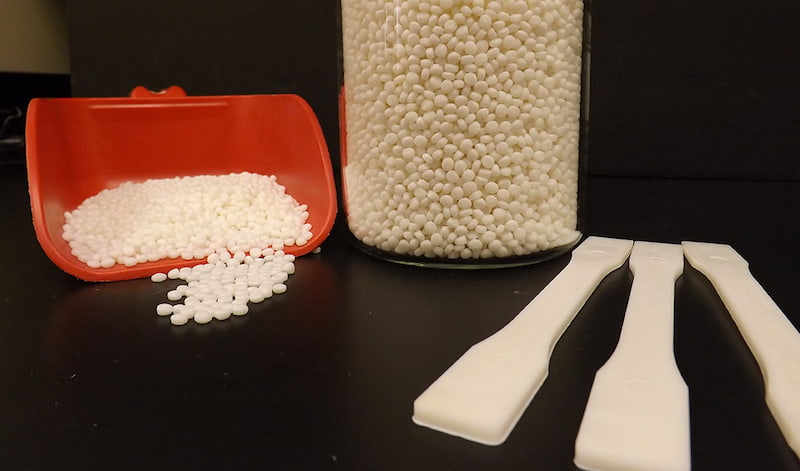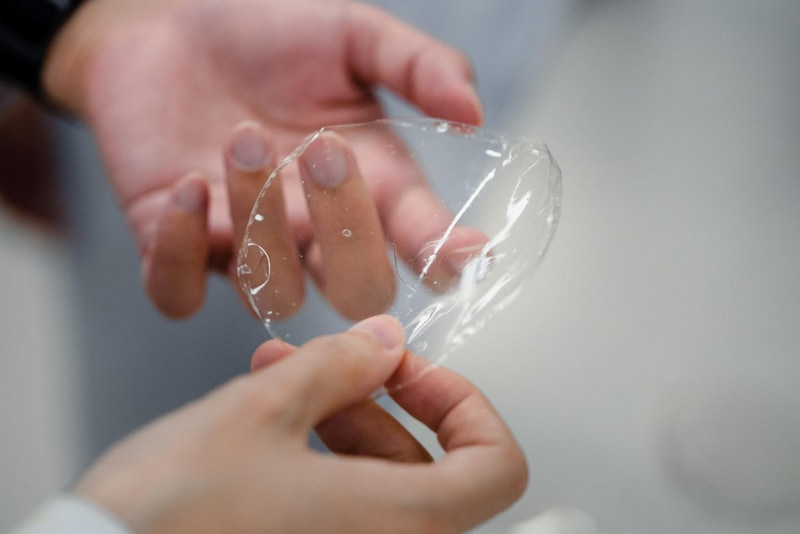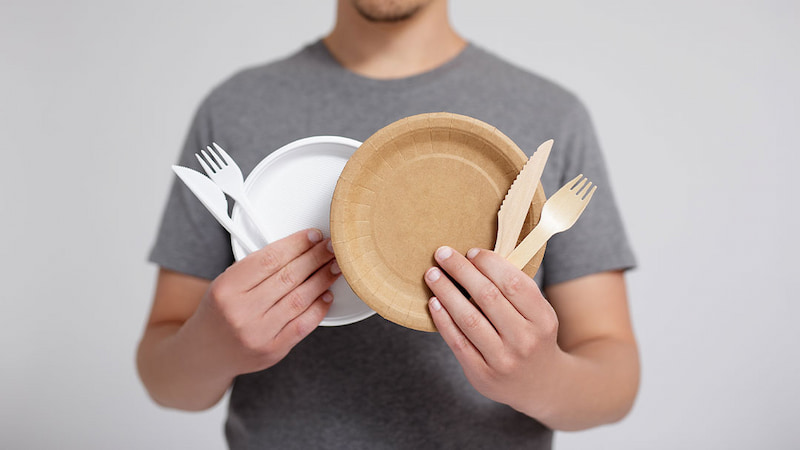Bioplastics are an alternative to traditional plastics which are made from non-renewable fossil fuels. Unlike traditional plastics that are produced from petroleum, bioplastics are manufactured from renewable biomass sources such as vegetable fats and oils, maize starch, straw, woodchips, sawdust, recovered food waste, and other similar materials. Many varieties of bioplastics are more environmentally friendly yet have many of the same benefits as traditional plastics, such as flexibility and durability.

Starch-based bioplastics are made from renewable resources such as corn, potato, and cassava starch. It is produced using a combination of starch and plasticizer. Here are the general steps involved in producing starch-based bioplastics:
- Raw material selection: The raw materials used in the production of starch-based bioplastics are typically renewable resources such as corn, potato, and cassava starch.
- Starch extraction: The first step in the production process involves extracting starch from the selected raw material. This is typically done by washing and separating the starch granules from the other components of the raw material.
- Plasticizer addition: Once the starch is extracted, it is mixed with a plasticizer such as glycerol or sorbitol. The plasticizer helps to increase the flexibility and strength of the bioplastic.
- Extrusion: The starch and plasticizer mixture is then heated and extruded through a die to form the desired shape. Other additives such as water, pigments, and fillers can also be added to the mixture to improve the properties of the bioplastic.
- Forming and shaping: The extruded bioplastic is then formed and shaped into various products such as cutlery, bags, and packaging materials.
- Finishing: The final step involves finishing the bioplastic product by trimming excess material and polishing the surface.
Starch-based bioplastics offer a sustainable and eco-friendly alternative to traditional plastics, as they are made from renewable resources and can be biodegradable and compostable. Some of the applications are:
- Packaging materials (e.g. bags, containers, wrapping films)
- Foodservice items (e.g. cutlery, plates, cups)
- Agriculture applications (e.g. mulch films, nursery pots)
- Textiles (e.g. clothing, accessories)
- Medical devices (e.g. syringes, surgical gloves, tubing)
2.2. Cellulose-based bioplastics

Cellulose-based bioplastics are made from cellulose, a naturally occurring polymer found in plant cell walls. These bioplastics are renewable and biodegradable, then become an eco-friendly alternative to traditional plastics.
The production process of cellulose-based bioplastics involves the following steps:
- Cellulose extraction: Extract cellulose from plant sources such as wood pulp or cotton through a process called pulping, where the plant material is broken down using chemicals or mechanical methods.
- Dissolution: Once the cellulose is extracted, it is dissolved in a solvent such as ionic liquids or N-methyl morpholine-N-oxide (NMMO). This process is essential to break down the cellulose into smaller molecules that can be molded into different shapes.
- Casting and shaping: The dissolved cellulose is then cast into sheets or molded into different shapes using techniques such as injection molding or extrusion.
- Drying and finishing: The final step involves drying the cellulose-based bioplastic and finishing it to achieve the desired surface properties.
2.3. Protein-based bioplastics

Protein-based bioplastics are made from natural proteins such as soy protein, whey protein, and zein. The production process for protein-based bioplastics involves several steps:
- Extraction: The first step is to extract the protein from plant or animal sources. This can be done through various methods such as precipitation, filtration, or centrifugation.
- Purification: Once the protein is extracted, it is purified to remove any impurities and ensure that the protein is in its purest form.
- Mixing and molding: The purified protein is mixed with other natural materials such as starch or cellulose and molded into different shapes and forms.
- Completing: The final step involves drying the protein-based bioplastic and finishing it to achieve the desired surface properties.
Areas of application:
- Food industry: Provider of nutrients for both humans and animals and food packaging
- Transport logistics: Filler or protection
- Alternative to chemical binders/adhesives: Replace chipboard and other semi-finished goods, such as those used in trade show building.
- Agriculture: Agriculture includes mulch films, plant binders, vine clips, and nitrogen fertilizer storage.
- Horticulture: Supports, flower pots, etc.
- Forestry: Identifying marks, protective sleeves for young trees, etc.
- Fishing equipment for single use: as mussel nets, fastening clamps, etc.
- Recreation: Fireworks, filling for hunting cartridges, etc.
2.4. Bio-derived polyethylene
Bio-derived polyethylene, commonly referred to as renewable polyethylene, is a kind of polyethylene generated from ethanol, which is converted to ethylene via the process of dehydration. It may be produced using a variety of feedstocks, such as wheat grain, sugar beetroot, and cane.
The production process for bio-derived polyethylene involves the following steps:
- Feedstock cultivation: Sugarcane or corn is grown as a renewable source of biomass. Sugarcane is a common feedstock for bio-derived polyethylene, as it contains high levels of sucrose, which can be converted into ethanol.
- Fermentation: The biomass is fermented to produce ethanol. The sugarcane or corn is crushed and mixed with water to form a juice, which is then heated to produce syrup. The syrup is then fermented using yeast, which converts the sucrose into ethanol.
- Dehydration: The purified ethanol is dehydrated to produce ethylene. The ethanol is purified to remove any impurities, and then dehydrated using a catalyst to produce ethylene.
- Polymerization: The ethylene is then polymerized to form polyethylene. The ethylene is polymerized using a catalyst, which links the ethylene molecules together to form a polymer. The resulting polyethylene can be used in the same applications as traditional polyethylene.
2.5. Aliphatic polyesters
An aliphatic polyester is a long-chain polymer that consists of repeating ester groups It can be broken down by bacteria and other living things, which is why it is regarded as a biodegradable molecule. Aliphatic polyesters are much more ecologically friendly than conventional polyesters because of this characteristic.
Uses for aliphatic polymers include:
- Facilitate tissue engineering, create scaffolds
- Assemble drug delivery systems
- Create medical equipment
- Make significant strides in the biotechnology and medical fields
Aliphatic polyesters are made from a variety of naturally occurring substances, including:
- Lactide: A cyclic ester made from two or more lactic acid molecules
- Glycolide: Lactic acid and glycolic acid are copolymerized to form glycolide.
- Caprolactone: Another biomedical polymer utilized in biomedical engineering is caprolactone.
The process for making aliphatic polyesters typically involves the following steps:
- Monomer production: The monomers used to create aliphatic polyesters are typically derived from renewable resources and produced by breaking down the raw material through chemical or enzymatic processes.
- Polymerization: The monomers are then polymerized, or linked together, using a catalyst such as an acid or enzyme.
- Purification: The resulting polymer is then purified to remove any impurities or unreacted monomers using methods such as washing, precipitation, or chromatography.
- Processing: The purified aliphatic polyester can then be processed into various forms such as films, fibers, or molded objects by extrusion, injection molding, or melt spinning.
- Post-treatment: Some aliphatic polyesters may require additional post-treatment to enhance their properties or functionality (eg: heat setting, surface modification, or blending with other materials).
2.6. Polyamide 11 bioplastic
Polyamide 11 bioplastic, also known as PA 11 or Nylon 11, is a biodegradable and bio-based polymer derived from castor oil. It was discovered in 1947 by three French scientists from the business Organico in Serquigny. Fibers made of polyamide 11 were first utilized to create thin textiles. Because of their high manufacturing costs, they were replaced by nylon in the 1970s.
The production of PA11 bioplastic is a relatively simple and environmentally-friendly process, as it utilizes renewable resources and produces fewer greenhouse gas emissions than traditional petrochemical-based plastics. Here is a brief overview of the production process:
- Extraction of Castor Oil: Castor oil is extracted from the seeds of the castor plant.
- Purification: The crude castor oil is purified to remove impurities such as moisture, free fatty acids, and other contaminants.
- Polymerization of Castor Oil: The purified castor oil is then polymerized to form nylon-11. This involves combining the castor oil with a catalyst and heating it to a high temperature.
- Pelletization of Nylon-11: The nylon-11 is then extruded into pellets or beads, which can be used to manufacture a variety of products.
- Production of Bioplastic: The nylon-11 pellets are melted and extruded into the desired shape using injection molding or other similar techniques.
Polyamide 11 applications
- Tubing: Umbilical hoses, catheters, fuel lines, hydraulic hoses, air lines, and beverage tubing.
- Electrical: Sheathing for cables and wires, as well as housings, connections, and clips.
- Coatings: Used in metal coatings for noise reduction, UV exposure protection, chemical, abrasion, and corrosion resistance.
- Textiles: Woven and technical textiles, lingerie, filters, and brush bristles.
- Sports equipment: Racket strings, eyelets, badminton shuttlecocks, and layers of skis are all used in racket sports.
2.7. Polyhydroxy urethane plastics
Polyhydroxy urethane (PHU) is produced by polymerizing urethane prepolymers with hydroxyl-containing compounds such as glycerol or sorbitol. PHU plastics are commonly made from renewable resources, such as plant-based oils and sugars, and are often used in various applications such as packaging, biomedical devices, and textiles.
The production process of PHU plastics involves the following steps:
- Synthesis of Urethane Prepolymer: An isocyanate compound is reacted with a polyol to form a urethane prepolymer.
- Incorporation of Hydroxyl Group: The urethane prepolymer is then reacted with a hydroxyl-containing compound, such as glycerol or sorbitol, to incorporate hydroxyl groups into the prepolymer.
- Polymerization: The prepolymer with incorporated hydroxyl groups is then polymerized using a catalyst such as tin (II) octanoate or dibutyltin dilaurate.
- Post-Polymerization: The polymerized PHU is further processed by post-polymerization reactions such as crosslinking or chain extension to improve its mechanical and thermal properties.
Note: The process can be modified to include additional steps such as blending with other biodegradable polymers or adding plasticizers to improve flexibility.
PHU plastics have several advantages over traditional petrochemical-based plastics. They are biodegradable and can be safely disposed of in the environment, reducing the accumulation of plastic waste. They are also made from renewable resources, reducing dependence on fossil fuels. In addition, PHU plastics have good mechanical and thermal properties, helping them become suitable for a wide range of applications.
PHU plastics are still relatively new and not yet widely used in commercial applications. However, ongoing research and development in this area are likely to lead to increased use of PHU plastics in the future as more eco-friendly alternatives to traditional plastics are sought.
2.8. Genetically modified bioplastics
Genetically modified bioplastics are produced by genetically modifying organisms such as bacteria or yeast to produce specific enzymes or proteins that are used in the production of bioplastics. These modified organisms can be engineered to produce biodegradable plastics from renewable resources.
- Identification and cloning of genes: Identify and clone the genes responsible for the production of the desired bioplastic in organisms that naturally produce it. These genes are then inserted into the target organism, which could be bacteria, yeast, or other microorganisms.
- Modification of the organism: The target organism is then genetically modified using various techniques such as recombinant DNA technology, gene editing, or gene synthesis to introduce the cloned genes and enable it to produce the desired bioplastic.
- Fermentation: The modified organism is then grown in a bioreactor or fermenter in a nutrient-rich medium that contains the necessary raw materials for the production of the bioplastic. The organism then produces the bioplastic as it grows.
- Harvesting and purification: Once the bioplastic is produced, it is harvested from the fermentation broth and purified using techniques such as filtration, centrifugation, or solvent extraction to remove any impurities or contaminants.
- Processing: The purified bioplastic can then be processed using various techniques such as extrusion, injection molding, or blow molding to produce the final product.
Genetically modified bioplastics have several potential advantages over traditional petrochemical-based plastics. They are biodegradable and can be safely disposed of in the environment, reducing the accumulation of plastic waste. They are also made from renewable resources, reducing dependence on fossil fuels.
However, there are also concerns about the potential environmental impacts of genetically modified organisms and their products. Some critics argue that these organisms may escape into the environment and disrupt ecosystems, or that they may lead to the development of antibiotic-resistant bacteria. As with any new technology, the development and use of genetically modified bioplastics will need to be carefully monitored and regulated to ensure that they are safe and do not have negative environmental or health impacts.
The production of bioplastics offers a promising alternative to traditional petrochemical-based plastics. As the demand for sustainable materials continues to grow, the development and production of bioplastics will play an increasingly important role in reducing the negative impact of plastic waste on the environment.